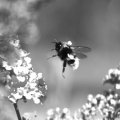New drilling systems developed by Brisbane mining engineers will improve the safety of underground coal mines, helping prevent disasters such as those at Moura in past years.
The Co-operative Research Centre for Mining Technology and Equipment (CMTE), in which the University of Queensland is a core partner, has developed two new drilling systems which use high pressure water jets as the cutting tool.
CMTE chief executive officer Professor Mike Hood said the new technologies, being developed in partnership with the industry, were likely to 'enhance immeasurably' the safety of underground coal mining operations.
He said extracting methane gas from coal seams continued to be a difficult but necessary task at many underground coal mines in Australia. The new drilling systems would make this task easier.
Professor Hood described the methane gas in coal as 'both friend and foe'.
'This gas potentially represents a very large and valuable resource of clean energy, but unless drained from the coal seam prior to any underground mining operation the gas presents a hazard for explosions and sudden outbursts,' he said.
'Tragically, Australian miners have been killed by both of these types of events in recent years.'
Professor Hood cited a recent article in Business Review Weekly which said coalbed methane could almost double Australia's natural gas reserves, with Queensland alone having a 'potentially recoverable' 13,000 petajoules of coalbed methane energy. Queensland currently consumes only 45pJ of natural gas per year.
Draining the gas is achieved by drilling a pattern of holes in the coal seam, currently using 'slow, expensive and only partially effective' drilling methods, he said.
'The new systems which have been developed potentially drill at 10 times the rate of conventional drills and they have a natural tendency to drill straight holes and to remain in-seam,' he said.
'One of these drilling systems operates from holes drilled from the surface and the other drills holes in underground mines.
'We are working with BHP Coal to commercialise the surface drilling system and with Shell Coal and the Australian Coal Association Research Program to develop the underground drilling system.'
Professor Hood said an integral part of these projects was the development of geophysical sensors to monitor the position of the drill in real time and allow it to be 'steered' to remain within an often undulating seam horizon.
For more information, contact Professor Hood on (07) 3212 4521.



